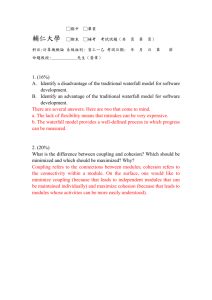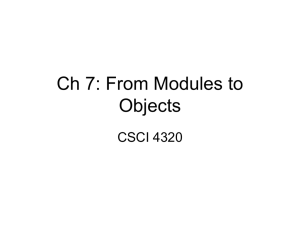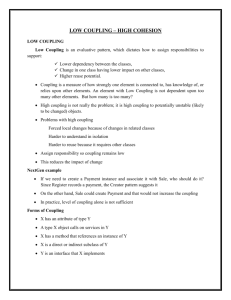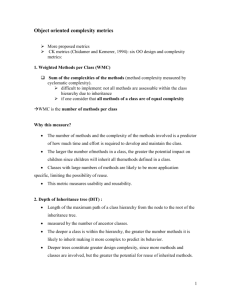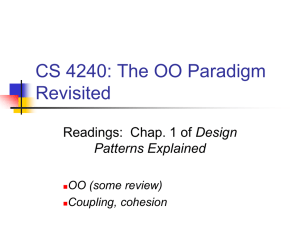Simple Program Design
advertisement
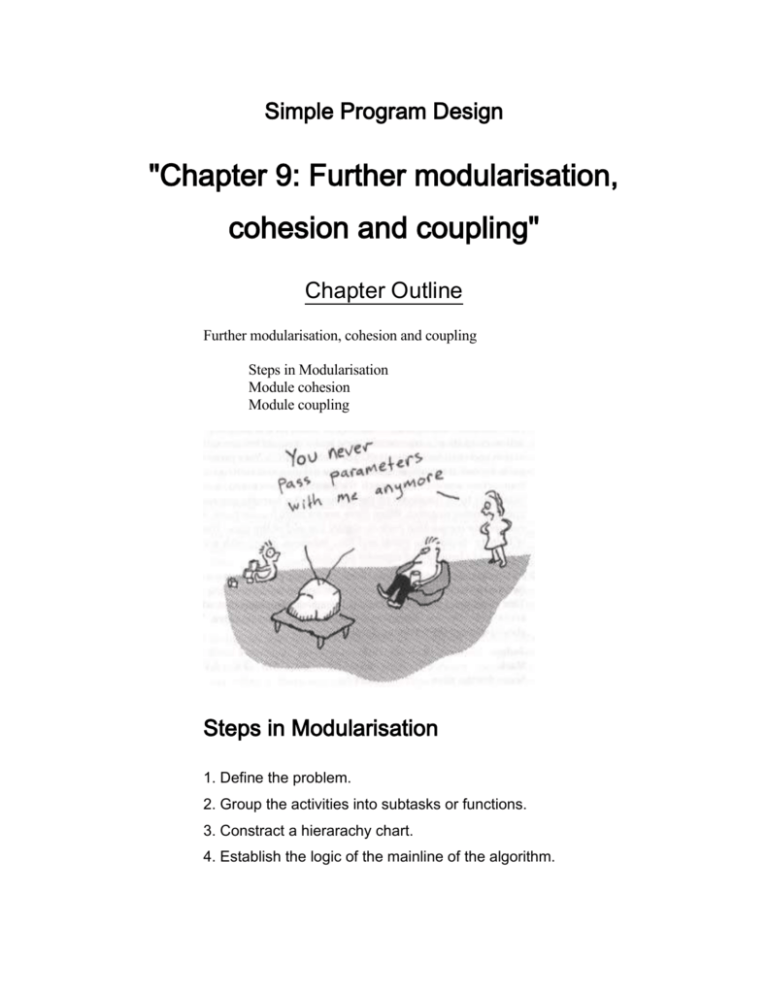
Simple Program Design
"Chapter 9: Further modularisation,
cohesion and coupling"
Chapter Outline
Further modularisation, cohesion and coupling
Steps in Modularisation
Module cohesion
Module coupling
Steps in Modularisation
1. Define the problem.
2. Group the activities into subtasks or functions.
3. Constract a hierarachy chart.
4. Establish the logic of the mainline of the algorithm.
5. Develop each successive module.
6. Desk check the solution.
Example 9.1 Calculate vehicle registration costs
A program is required to calculate and print the
registration cost of a new vehicle that a customer has
ordered. The input details required are:
Owner's name
Vehicle make
Vehicle model
Weight (in kg)
Body type (sedan or wagon)
Private or business code ('P' or 'B')
Wholesale price of vehicle
The vehicle registration cost is calculated as the sum of the
following charges:
The output on the screen is as follows:
Vehicle make:
Vehicle model:
Body type:
Registration fee:
Tax levy:
Weight tax:
Insurance premium:
Total registration charges:
Federal tax:
Total amount payable:
A Define the problem
Here is the IPO chart for the Vehicle Registration
problem..
B Group the activities into modules
The activities in the processing component can be
grouped into three main functions, as follows:
1. Get input details.
2. Display details to screen.
3. Calculate the total amount payable.
C Construct a hierarchy chart
Here is a Structure Chart for the problem.
D Establish the logic of the mainline of the algorithm
using pseudocode
The mainline requires a DOWHILE loop and calls to
the modules as required.
E Develop the pseudocode for each successive
module in the hierarchy chart.
Here is the get vehicle details module.
Here is the calculate total amount due module.
Here is the calculate federal tax module
Here is the calculate total registration module.
Finally, here is the Display registration details module.
F Desk check the solution algorithm
Here is the test input data.
Here are the expected results.
Here is the condensed desk check table.
Module Cohesion
A module performs a single function, has a single
entry and a single exit. Cohesion is a measure of how
well the code of a module fits together in doing a
single function! Here is a chart of different types of
cohesion.
Coincidental cohesion
The weakest form of cohesion a module can have is
coincidental cohesion. It elements have no
meaningful relationship. It might occur on older
systems because a module couldn't have more then
50 program statements! Here is an example of a
coincidental cohesion module.
Logical cohesion
Logical cohesion occurs when the elements of a
module are grouped together according to a certain
class of activity. Here is an example of logical
cohesion in the module read all files.
Temporal cohesion
Temporal cohesion occurs when the elements of a
module are grouped together because they are
related by time. Initialization and finalization module
are examples of this.
Procedural cohesion
Procedural cohesion occurs when the elements of a
module are related because they operate according to
a particular procedure, or sequence of execution. The
following read student records and total student ages
is such a module. The "and" in its name tells that it
doesn more than one function!
Communicational cohesion
Communicational cohesion occurs when the elements
of a module are grouped together because they all
operate on the same (central) piece of data. Here is
an example in the validate product record module.
Sequential cohesion
Sequential cohesion occurs when a module contains
elements that depend on the processing of previous
elements. The following process purchase has
sequential cohesion.
Functional cohesion
Functional cohesion occurs when all the elements of
a module contribute to the performance of a single
specific task. The following calculate sales tax module
has functional cohesion.
Summary of cohesion levels
When designing modules, try to form modules that
have a single problem-related function. If functional
cohesion is achieved, the modules will be more
independent, easier to read and understand, and
more maintainable than modules with lesser
cohesion.
Module Coupling
When designing a program, look not only at the
cohesion of modules but also at the flow of
information between modules. The connections
between modules are called interfaces or couples.
Tight coupling implies large dependence on the
struture of one module by another. Losse coupling
makes for more independent and easier to maintain
modules. Here is Yourdon and Constantine's coupling
scale.
Common coupling
Common coupling occurs when modules reference
the same global data structure. A data structure is a
collection of variables.
The following pseudocode example shows two
modules that experience common coupling because
they both access the customer record.
External coupling
External coupling occurs when two or more modules
access the same global data variable.
The following shows that two modules both access
the sale_tax data item.
Control coupling
Control coupling occurs when a module passes
another module a control variable that is iintended to
control the other module's logic.
Here is one module passing another a control
parameter.
Stamp coupling
Stamp coupling occurs when one module passes a
non-global data structure to another module.
Here, one modules passes another the current_record
data structure.
Data coupling
Data coupling occurs when a module passes a nonglobal data variable to another module.
Here the total_price and sales_tax varaibles are
passed to another module.
A summary of coupling levels
You should aim towards module independence and a
minimum of information interchange between
modules. 1. Pass data to a subordinate module in the
form of parameters. 2. Write each subordinate
modules as a self-contained unit that can accept data
as parameters and not modify global data.
